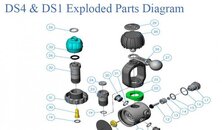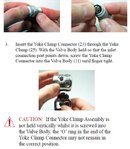You are using an out of date browser. It may not display this or other websites correctly.
You should upgrade or use an alternative browser.
You should upgrade or use an alternative browser.
A llittle leak might not be so innocent after all.
- Thread starter raftingtigger
- Start date
Please register or login
Welcome to ScubaBoard, the world's largest scuba diving community. Registration is not required to read the forums, but we encourage you to join. Joining has its benefits and enables you to participate in the discussions.
Benefits of registering include
- Ability to post and comment on topics and discussions.
- A Free photo gallery to share your dive photos with the world.
- You can make this box go away
I could easily see this happening. Relatively inexperienced diver, doesn't work on his own gear. Has a dive where he has a yoke o-ring leak, and the DM reassures him it's no big deal. Has another one, still no big deal . . . eventually the brain generalized into, "Small leaks from the yoke connection are no big deal," without understanding that there are leaks, and leaks.
Good post, but it might help newer divers if somebody put up a photograph of a yoke regulator to show what the parts are that we are talking about. (I'd do it, but I'm not home and have no access to my dive gear at the moment.)
A few pictures.
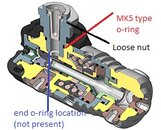
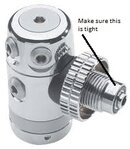
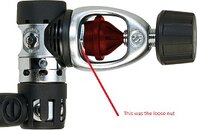
Attachments
billt4sf
Contributor
This is good info, especially the picture with the red arrow on the right. I don't understand the other two pics, sorry.
I had no idea. I certainly have been on MANY dives with a little leak somewhere around there, and I don't recall anyone ever paying attention, even when I called it out to them, which I kind of stopped doing until I took Fundies.
As a matter of fact, I don't recall anyone ever aborting a dive due to any small leak.
- Bill
This is good info, especially the picture with the red arrow on the right. I don't understand the other two pics, sorry.
I had no idea. I certainly have been on MANY dives with a little leak somewhere around there, and I don't recall anyone ever paying attention, even when I called it out to them, which I kind of stopped doing until I took Fundies.
As a matter of fact, I don't recall anyone ever aborting a dive due to any small leak.
- Bill
Bill4sf, A small leak between the valve o-ring and the regulator isn't a big deal and not that uncommon. That is what I thought it was when I saw it underwater. In this case it was a leak between the regulator yoke and the body of the regulator. As said, this has the potential for being a big problem.
The first picture shows a cut-away of a yoke regulator with the yoke not shown. It shows the o-ring that seals the yoke retaining nut to the regulator body.
The second picture is of a DIN regulator (since I mentioned mine) and the equivalent part to the yoke retaining nut.
As for the lack of aborts: Where we dive it is a lot of work to get out to where we descend (cold water, shore diving, with significant swims) and small leaks are relatively common. Does that make it right? No, it is actually a practice called "normalization of deviance", but then again it is unlikely to change. My suggestion is to at least do a bubble check near shore and KNOW which are benign leaks and which are not.
Actually, that small leak between the valve O-ring and the main body is a potentially big deal. The reason is that, rather than being "dirty," many of these O-rings are actually damaged and could blow out underwater. If the regulator body is not snug against the O-ring indent, there is a gap that can allow the O-ring to actually extrude through that space. This is especially true if it has been cut or otherwise damaged.Bill4sf, A small leak between the valve o-ring and the regulator isn't a big deal and not that uncommon. That is what I thought it was when I saw it underwater. In this case it was a leak between the regulator yoke and the body of the regulator. As said, this has the potential for being a big problem.
The first picture shows a cut-away of a yoke regulator with the yoke not shown. It shows the o-ring that seals the yoke retaining nut to the regulator body.
The second picture is of a DIN regulator (since I mentioned mine) and the equivalent part to the yoke retaining nut.
As for the lack of aborts: Where we dive it is a lot of work to get out to where we descend (cold water, shore diving, with significant swims) and small leaks are relatively common. Does that make it right? No, it is actually a practice called "normalization of deviance", but then again it is unlikely to change. My suggestion is to at least do a bubble check near shore and KNOW which are benign leaks and which are not.
(emphasis added, jcr)
Many people don't realize the reason for the yolk cap is two-fold. One is to protect the regulator from sea water once it's off the tank valve. But the other, which today may not be realized, is to keep a spare O-ring available for a diver with a bad one. This problem should be detected when the regulator is first mated to the tank.
If there is any release, any air escaping, from the tank O-ring, the O-ring needs to be replaced ASAP. This is what dive masters and group leaders are paid to catch.
From a safety professional's perspective, this "normalization of deviance" is a prescription for overlooking something that can lead to a serious accident. Let's say this O-ring situation (between the valve and regulator) leads a blowout underwater. Immediately, there is little air supply, and what's available to the regulator is exhausted very quickly. This leads to air sharing under stressed conditions (there is a lot of noise associated with this kind of blow-out, and a lot of bubbles). So a small leak, which leads to a major loss of air, could become the trigger to an overpressure accident, to decompression sickness, or to panic that leads to drowning. In the safety profession, we try to find these "normalization of deviance" situations, and "de-normalize" them.
Does that mean I don't dive with leaks? No, but I do evaluate them prior to diving. Here's a fairly long video I made of a dive with the Dacor Nautilus CVS, but in the beginning I found a leak in my regulator's HP hose for the computer. You can see how I handled it; that segment starts at 11:43 into the video.
[video=youtube;ydnE52L_Nqw]https://www.youtube.com/watch?v=ydnE52L_Nqw[/video]
You will note that I continued this dive with the leaking HP hose. Here's what I went through mentally. I could abort the dive, but any leak out the HP hose would be regulated by that very tiny hole in the regulator body designed specifically to prevent rapid air loss. Also, I was river diving solo, but at a max depth of 25 feet, so an out-of-air emergency would be no big deal for simply surfacing. In fact, out-of-air was a very remote possibility. Finally, this hose was never dived again.
SeaRat
John C. Ratliff
NAUI 2710 (retired), CSP (Certified Safety Professional)
Last edited:
AfterDark
Contributor
To this day I still have an O-ring in the reg cap even though I have a half dozen of them in my save a dive box. Good habits should be retained. I also change my O-rings at least once a year at VIP the last 10 years that's been enough. 
The scenario you describe is the primary reason I've shunned octo regs since the concept came on the diving scene. Both regs have a common and single failure point, the 1st stage and/or Oring. In the past the other divers I dived with where like me skilled in buddy breathing, that is sharing the same second stage, so an octo just seemed silly to me/us. Since the people these days are trained differently, I sling a 19cuft bottle in lieu of an octo or nothing. It may not be what they are used to but if there's nothing else to breathe they'll come around. When I solo dive the pony stays in the barn, if I can't conduct a safe dive with two independent tanks and regs sans pony then I need to hang up the fins.
When I solo dive the pony stays in the barn, if I can't conduct a safe dive with two independent tanks and regs sans pony then I need to hang up the fins.
Nice video by the way I watched it a while ago on you tube. I had one of those units, I dove it for 4 years, 1 year with fancy auto inflator and 3 years with a standard inflator. I still have the 25 lb lead ingot I cast for the weight compartment under the tank. The unit itself hangs in the Giant Strides Dive shop in Warwick, RI.
The scenario you describe is the primary reason I've shunned octo regs since the concept came on the diving scene. Both regs have a common and single failure point, the 1st stage and/or Oring. In the past the other divers I dived with where like me skilled in buddy breathing, that is sharing the same second stage, so an octo just seemed silly to me/us. Since the people these days are trained differently, I sling a 19cuft bottle in lieu of an octo or nothing. It may not be what they are used to but if there's nothing else to breathe they'll come around.
Nice video by the way I watched it a while ago on you tube. I had one of those units, I dove it for 4 years, 1 year with fancy auto inflator and 3 years with a standard inflator. I still have the 25 lb lead ingot I cast for the weight compartment under the tank. The unit itself hangs in the Giant Strides Dive shop in Warwick, RI.
Similar threads
- Replies
- 7
- Views
- 1,013



